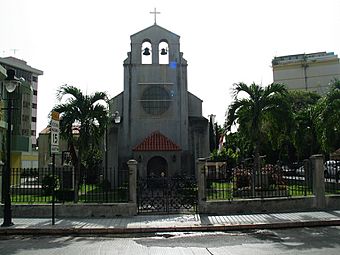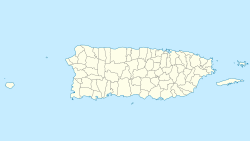Iglesia de la Santísima Trinidad facts for kids
Quick facts for kids |
|
|
Iglesia de la Santísima Trinidad
|
|

Holy Trinity Church in Barrio Cuarto in August 2010
|
|
| Location | Intersection of Marina, Mayor, and Abolicion streets, Ponce, Puerto Rico |
|---|---|
| Built | 1873 |
| Architectural style | Late Gothic Revival, Mission/Spanish Revival church from a Bungalow/Craftsman, Neo Gothic |
| NRHP reference No. | 86002766 |
| Added to NRHP | 29 September 1986 |
The Iglesia de la Santísima Trinidad (which means Holy Trinity Church) is a special church in Ponce, Puerto Rico. It was started by British people living there in 1869. They built their first church building in 1873.
This first church was made of wood and metal. Queen Victoria's government even sent materials to help build it. This included a bell made in England in 1870. The church is located where Marina, Mayor, and Abolicion streets meet. It was the very first Anglican church ever built in Puerto Rico. In 1898, it was still the only Protestant church on the island.
The old church building became too old and worn out. So, a new church was built in its place in 1926. The same 1870 bell was put into the new building. This church is a mix of English neo-Gothic and Spanish-colonial styles. The Holy Trinity Church was added to the U.S. National Register of Historic Places on September 29, 1986.
Contents
What the Church Looks Like
| Most Holy Trinity Episcopal Church | |
|---|---|
| Most Holy Trinity-aided Parish | |
| Trinity Church Ponce, Iglesia de la Trinidad de Ponce, La Trinidad, The Trinity | |
|
Parroquia Ayudada Santisima Trinidad
|
|
| Language(s) | Spanish & English |
| Denomination | Anglicanism |
| Tradition | Broad church to Low church |
| History | |
| Founder(s) | Queen Victoria by request of local Englishmen |
| Relics held | Religious Liberty Bell of Puerto Rico |
| Administration | |
| Diocese | Puerto Rico Episcopal Diocese |
| Province | Province II of the Episcopal Church |
The Holy Trinity Church, built in 1926, stands on its own. It is on the east side of "calle Marina," where it meets "calle Mayor" and "calle Abolición." This area is a public space where the streets come together.
Church Design
The church building has a shape like a cross, which is called a cruciform plan. It has a tall main area called a nave. There's also a balcony inside, above the main entrance. The walls inside are plain, without any decorations.
Outside Features
The outside of the church mixes two styles: neo-Gothic and Spanish-Colonial. The church walls have supports called buttresses between the windows. The roof is made of ceramic tiles, which is common for mission-style churches.
The front of the church shows a mix of North-American and Hispanic styles. It has a tall, rectangular front with a bell tower on top. This tower has two arches with bells inside and a cross at the very top. This design is similar to many old churches on the island.
However, the front also has buttresses on the sides. It has a round window on the second floor. These parts remind us of neo-Gothic churches found in the United States.
Entrance Area
A small, one-story section sticks out at the front. This is the reception area or foyer. It has a rounded arch entrance with iron grilles. This area has a sloped roof made of Spanish tiles. Its walls are painted white, which is different from the main church building. This makes it look like a mission-style part added to a Gothic building.
A small garden surrounds the church. It is separated from the sidewalk by iron fences with concrete posts.
Why This Church Is Important
For a long time, Spain only allowed Catholics to live in its colonies. This meant Protestants and Jews were not allowed. But later, in the late 1700s and early 1800s, Spain changed its rules. They wanted to attract more people to help their colonies grow.
Freedom of Worship
In 1868, the Spanish king was no longer in power. A new government was formed, and in 1869, they passed a law called the "Tolerance of Worship Act." This law allowed people to practice different religions.
Because of this new law, the first organized Protestant church services in Puerto Rico happened in Ponce in 1869. British and other Protestant residents started them. In that same year, this group decided to create an Anglican church, which became the Holy Trinity Church.
Gifts from a Queen
Materials for the church came from Britain. These were a gift from Queen Victoria to her British people living far away. The gifts included a bell made in England in 1870. The church building started being built in 1873.
A Time of Change
After 1874, the Spanish king returned to power. The rules about religion became strict again. The government ordered Holy Trinity Church to close. But Queen Victoria and the British government stepped in to help.
The Spanish king allowed the church to stay open, but with rules. The front doors had to stay closed. The bell was not allowed to ring. And no services could be held in Spanish. These rules stayed in place until July 25, 1898. On that day, United States troops arrived in Ponce.
When the troops entered, the church members rang the bell. They rang it to welcome the soldiers and celebrate that they could now worship freely. This bell is still known as the 'Freedom Bell' by the people of Ponce.
A New Building
By 1923, the old wooden and metal church was too damaged to fix. People raised money to build a new, stronger church on the same spot. The new church was finished in 1926. It was built under the guidance of Reverend Philip Locke. He was the church leader in Ponce from 1924 to 1931.
The new church combined neo-Gothic and Spanish colonial styles. The neo-Gothic style shows its British religious background. The Spanish colonial style represents the community it serves in Puerto Rico. This mix of styles is not common in Puerto Rico, making the church unique in Ponce. The 1870 bell from England was placed in this new church.
The Holy Trinity Church is a great example of how different styles, building methods, and cultures can come together. It also shows a time when Puerto Rico was changing. The church used concrete as a main material but kept old traditions like exposed wooden roofs and Spanish tiles.
The people of Ponce admire and respect this church. It combines different styles and has a rich history. It was listed on the National Register of Historic Places because of its importance.


